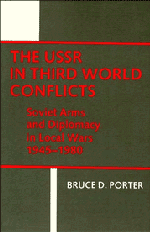Book contents
- Frontmatter
- Contents
- Preface
- 1 Introduction
- 2 The USSR in local conflicts: a historical overview
- 3 Soviet power projection: advances in postwar military capabilities
- 4 The case studies: a framework for analysis
- 5 The Yemeni civil war
- 6 The Nigerian civil war
- 7 The Yom Kippur war
- 8 The Angolan civil war
- 9 The Ogaden war
- 10 Conclusions
- Index
7 - The Yom Kippur war
Published online by Cambridge University Press: 05 August 2011
- Frontmatter
- Contents
- Preface
- 1 Introduction
- 2 The USSR in local conflicts: a historical overview
- 3 Soviet power projection: advances in postwar military capabilities
- 4 The case studies: a framework for analysis
- 5 The Yemeni civil war
- 6 The Nigerian civil war
- 7 The Yom Kippur war
- 8 The Angolan civil war
- 9 The Ogaden war
- 10 Conclusions
- Index
Summary
Even Israeli Prime Minister Golda Meir explains her troops' heavy losses as … the consequence of the growing might of the Arab forces, in whose training Soviet military specialists participated, and of the high quality of the Soviet weapons with which the Arabs are equipped.
Krasnaya Zvezda, October 20, 1973The Yom Kippur War was a watershed in world politics. Although the hostilities lasted only three weeks, the war profoundly affected the subsequent course of the Arab-Israeli dispute, altered the regional balance in the Middle East, damaged relations between Washington and Moscow, and traumatized the international economy by catalyzing OPEC's transformation into a potent and determined cartel. The war also underscored the USSR's maturing stature as a global power – it was the Soviet Union's first massive intervention during the postwar era on behalf of a non-Communist client engaged in all-out conflict and the first historical instance of its taking definite escalatory steps in a regional conflict central to U.S. interests. The unprecedented level of Soviet involvement must be attributed not only to the USSR's determination to maintain influence with the Arab states but also to advances during the 1960s in its military capabilities: the achievement of strategic parity with the United States, the expansion of airlift and sealift capacity, and the logistical experience gained in previous regional conflicts. The war, in effect, inaugurated a new and more turbulent stage of Soviet military activism in the Third World.
- Type
- Chapter
- Information
- The USSR in Third World ConflictsSoviet Arms and Diplomacy in Local Wars 1945–1980, pp. 113 - 146Publisher: Cambridge University PressPrint publication year: 1984

